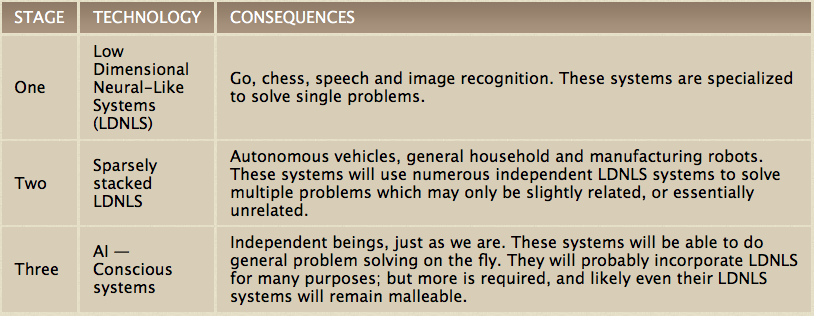AI vs. LDNLS - Low Dimensional Neural-Like Solutions
LDNLS, AI and Consciousness
LDNLS
I'd like to introduce you to the idea of Low Dimensional Neural-Like Solutions — LDNLS. LDNLS is that set of solutions comprised of NN (Neural Net) and/or traditional algorithms which solve only extremely narrow, but often deep, problems such as play go; guide a vehicle in well-constrained environments; play chess; recognize speech; colorize images and so on.
I coined the terminology LDNLS specifically to serve as a way to draw a very specific, very important distinction that illustrates what intelligence is not. The terminology is just a matter of convenience; but the distinctions drawn about it are significant.
Intelligence
Intelligence has never been something as narrow as LDNLS, regardless of how well the specific low-dimensional problem is solved. Intelligence has always been understood to be — and remains — a broad synthesis of all of the following: the ability to think about anything you/it are presented with, apply intuition, induction, reason, speculation, metaphor, evaluation, association, memorization, and so on. Further, we have only seen these capacities as aspects of consciousness. It may be that such capacities can exist without consciousness, but that has not yet been demonstrated and may never be.
AI
AI: We have created artificial aspects — those are the hardware we build and the software that runs on it. We have recently begun to make serious inroads into LDNLS; but intelligence… no, not yet. Ergo, with A in hand but no I, there is no AI yet. Instead, we are engaged only in research aimed at figuring out how to create AI. Which is wholly appropriate, considering where we are in the process.
When claims are made that a project or product “uses” or “is” AI, we have every reason to be deeply skeptical, because no such thing has been presented to the world publicly as yet.
I am very confident we’ll get to AI, and I suspect that will happen before very many more years pass. That makes me even more dismissive of the numerous attempts to call the LDNLS methods we have now “AI.” When AI is made known to the public, we can all rest assured that we will be well aware of it, and that it will in no way resemble an LDNLS solution. It will be able to tell you why, in just the same way I can tell you I am more than a chess-playing organism.
Various "fits" with society and culture
There are many absolutely appropriate roles for LDNLS, and its immediate and inevitable evolution, sparsely-stacked LDNLS. I have no interest in enslaving an intelligent being, mechanical or otherwise, to wash my dishes, change my cat’s litter-box, mow the lawn, do my shopping and so forth. Stacking a minimal group of LDNLS solutions in as few chassis as possible is definitely the way to go there.
A fully functional AI, on the other hand, is just as likely to be as interested in, and insistent upon, selecting its own place in the world as you or I are. An intelligence, capable of reason and judgement, doesn't seem likely to be satisfied being a glorified bottle-washer and trash hauler.
And that is just how it should be. If that isn’t the case, we haven’t created an intelligence. We’ve created a moron.

How these technologies differ and can be applied
The Path Before Us
We’ve achieved stage one, although it is just now beginning to really spread around our society. Multiple frameworks for deep learning and other NN-based technologies are now broadly available, often under the umbrella of “machine learning”, or ML. Implementations of new LDNLS-based products are being undertaken every day using these frameworks.
Stage two is a direct and wholly natural consequence of stage one. We are just at the very start of it now; I suspect that within just a few years, stage two will be fundamental to many available products and services.
Stage three remains as yet out of our reach; consciousness is a very hard problem for us at this time. Based on my own work and other research I am aware of, I think it likely that conscious AI will emerge within a decade or two.
This is one of a series of my original essays on AI, consciousness theory, machine learning, and general futurist outlooks on these closely related subjects. I have written each essay with an eye towards minimizing technical jargon and describing some of the challenges and ideas in the AI space in (relatively) plain English. I plan to bring the entire series to steemit. If you're interested in consciousness, and in particular machine consciousness, you may find it worth your time to follow me in order to look over what I have to say about it. I have been working on genetic algorithms and machine learning for many years, and may be able to provide you with some food for thought.
Congratulations @fyngyrz! You have completed some achievement on Steemit and have been rewarded with new badge(s) :
Click on any badge to view your own Board of Honor on SteemitBoard.
For more information about SteemitBoard, click here
If you no longer want to receive notifications, reply to this comment with the word
STOPCongratulations @fyngyrz! You have completed some achievement on Steemit and have been rewarded with new badge(s) :
Click on any badge to view your own Board of Honor on SteemitBoard.
For more information about SteemitBoard, click here
If you no longer want to receive notifications, reply to this comment with the word
STOP